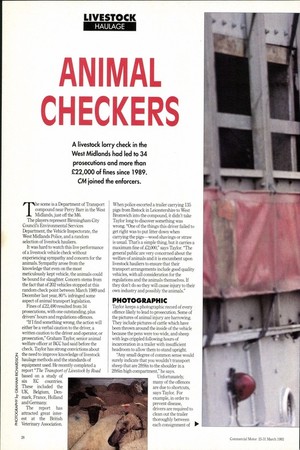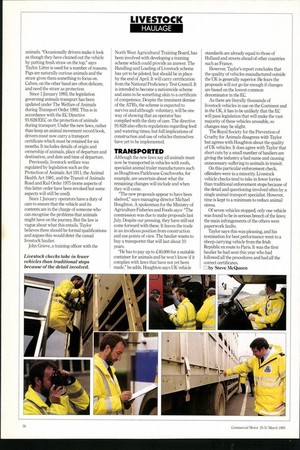ANIMAL CHECKERS
Page 30

Page 32

If you've noticed an error in this article please click here to report it so we can fix it.
A livestock lorry check in the West Midlands had led to 34 prosecutions and more than £22,000 of fines since 1989.
CM joined the enforcers.
The scene is a Department of Transport compound near Perry Barr in the West Midlands, just off the M6.
The players represent Birmingham City Council's Environmental Services Department, the Vehicle Inspectorate, the West Midlands Police, and a random selection of livestock hauliers.
It was hard to watch this live performance of a livestock vehicle check without experiencing sympathy and concern for the animals. Sympathy arose from the knowledge that even on the most meticulously kept vehicle, the animals could be bound for slaughter. Concern stems from the fact that of 202 vehicles stopped at this random check point between March 1989 and December last year, 80% infringed some aspect of animal transport legislation.
Fines of £22,490 resulted from 34 prosecutions, with one outstanding, plus drivers' hours and regulations offences.
"If I find something wrong, the action will either be a verbal caution to the driver, a written caution to the driver and operator, or prosecution," Graham Taylor, senior animal welfare officer at BCC had said before the check. Taylor has strong convictions about K the need to improve knowledge of livestock • haulage methods and the standards of o ,C4 equipment used. He recently completed a 02 report "The Transport of Livestock by Road • based on a study of isix EC countries. These included the O UK, Belgium, Den- -8' mark, France, Holland 1 and Germany.
has attracted report s attracted great inter- '5 est at the British I Veterinary Association. 28 When police escorted a trailer carrying 135 pigs from Ibstock in Leicestershire to West Bromwich into the compound, it didn't take Taylor long to discover something was wrong. "One of the things this driver failed to get right was to put litter down when carrying the pigs wood shavings or straw is usual. That's a simple thing, but it carries a maximum fine of L2,000," says Taylor. "The general public are very concerned about the welfare of animals and it is encumbent upon livestock hauliers to ensure that their transport arrangements include good quality vehicles, with all consideration for the regulations and the animals themselves. If they don't do so they will cause injury to their own industry and possibly the animals."
PHOTOGRAPHIC Taylor keeps a photographic record of every offence likely to lead to prosecution. Some of the pictures of animal injury are harrowing. They include pictures of cattle which have been thrown around the inside of the vehicle because the pens were too wide, and sheep with legs crippled following hours of incarceration in a trailer with insufficient headroom to allow them to stand upright.
"Any small degree of common sense would surely indicate that you wouldn't transport sheep that are 2ft9in to the shoulder in a 2ft6in high compartment," he says.
Unfortunately, many of the offences are due to shortcuts, says Taylor. For example, in order to prevent disease, drivers are required to clean out the trailer thoroughly between each consignment of animals. "Occasionally drivers make it look as though they have cleaned out the vehicle by putting fresh straw on the top," says Taylor. Litter is used for a number of reasons. Pigs are naturally curious animals and the straw gives them something to focus on. Calves, on the other hand are often delicate, and need the straw as protection.
Since 1 January 1993, the legislation governing animals transport has been updated under The Welfare of Animals during Transport Order 1992. This is in accordance with the EC Directive 91/628/EEC on the protection of animals during transport. Under the new laws, rather than keep an animal movement record book, drivers must now carry a transport certificate which must be retained for six months. It includes details of origin and ownership of animals, place of departure and destination, and date and time of departure.
Previously, livestock welfare was regulated by legislation such as the Protection of Animals Act 1911, the Animal Health Act 1981, and the Transit of Animals Road and Rail Order 1975 (some aspects of this latter order have been revoked but some aspects will still be used).
Since 1 January operators have a duty of care to ensure that the vehicle and its contents are in the charge of someone who can recognise the problems that animals might have on the journey. But the law is vague about what this entails. Taylor believes there should be formal qualifications and argues this would deter the casual livestock haulier.
John Grieve, a training officer with the North West Agricultural Training Board, has been involved with developing a training scheme which could provide an answer. The Handling and Loading of Livestock scheme has yet to be piloted, but should be in place by the end of April. It will carry certification from the National Proficiency Test Council. It is intended to become a nationwide scheme and aims to be something akin to a certificate of competence. Despite the imminent demise of the ATB's, the scheme is expected to survive and although voluntary, will be one way of showing that an operator has complied with the duty of care. The directive 91/628 also effects regulations regarding feed and watering times, but full implications of construction and use of vehicles themselves have yet to be implemented.
TRANSPORTED Although the new laws say all animals must now be transported in vehicles with roofs, specialist animal trailer manufacturers such as Houghtons Parkhouse Coachworks, for example, are uncertain about what the remaining changes will include and when they will come.
"The new proposals appear to have been shelved," says managing director Michael Houghton. A spokesman for the Ministry of Agriculture Fisheries and Foods says: "The commission was due to make proposals last July. Despite our pressing, they have still not come forward with these. It leaves the trade in an invidious position from construction and use points of view. The haulier wants to buy a transporter that will last about 10 years.
"He has to pay up to £40,000 for a suitable container for animals and he won't know if it complies with laws that have not yet been made," he adds. Houghton says UK vehicle standards are already equal to those of Holland and streets ahead of other countries such as France.
However, Taylor's report concludes that the quality of vehicles manufactured outside the UK is generally superior. He fears the proposals will not go far enough if changes are based on the lowest common denominator in the EC.
As there are literally thousands of livestock vehicles in use on the Continent and in the UK, it has to be unlikely that the EC will pass legislation that will make the vast majority of these vehicles unusable, so changes may be slight.
The Royal Society for the Prevention of Cruelty for Animals disagrees with Taylor but agrees with Houghton about the quality of UK vehicles. It does agree with Taylor that short cuts by a small number of hauliers are giving the industry a bad name and causing unnecessary suffering to animals in transit.
On this particular enforcement check, offenders were in a minority. Livestock vehicle checks tend to take in fewer lorries than traditional enforcement stops because of the detail and questioning involved often by a single animal transport specialist. However, time is kept to a minimum to reduce animal stress.
Of seven vehicles stopped, only one vehicle was found to be in serious breech of the laws; the main infringements of the others were paperwork faults.
Taylor says this was pleasing, and his nomination for best performance went to a sheep carrying vehicle from the Irish Republic en route to Paris. It was the first haulier he had seen this year who had followed all the procedures and had all the correct certificates.
El by Steve McQueen




















































































